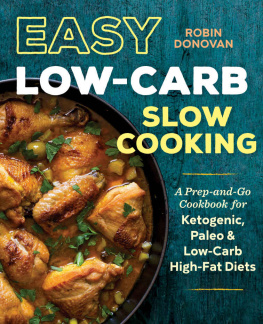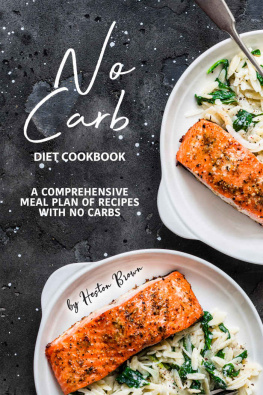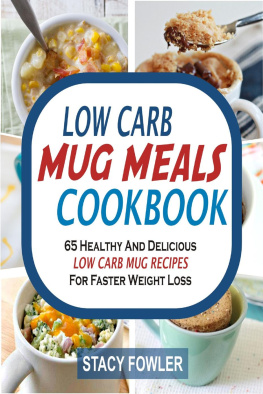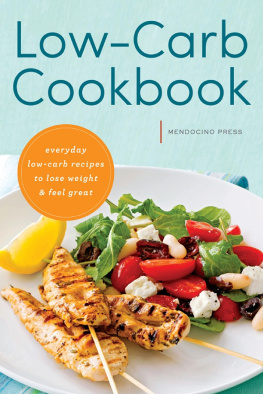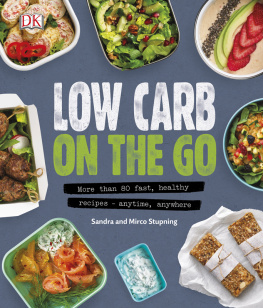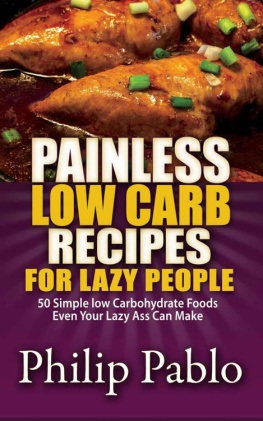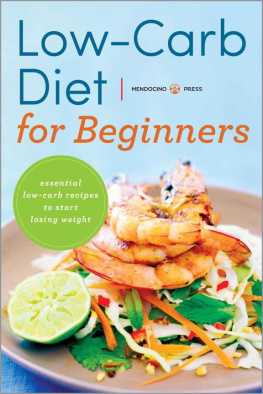CONTENTS
How to use this eBook
Preferred application settings
For the best reading experience, the following application settings are recommended:
Colour theme: White background
Font size: At the smallest point size
Orientation: Landscape (for screen sizes over 9), Portrait (for screen sizes below 9)
Scrolling view: [OFF]
Text alignment: Auto-justification [OFF] (if the eBook reader has this feature)
Auto-hyphenation: [OFF] (if the eBook reader has this feature)
Font style: Publisher default setting [ON] (if the eBook reader has this feature)
PREFACE
We are delighted that you want to prepare delicious low-carb dishes to take with you when youre out and about. We are often asked what is the easiest way to stick to a low-carb diet during lunch breaks or when traveling, especially since it is rare to find any low-carb carry-out options at your local sandwich counter. Our solution: prepare food at home and take it with you.
Our delicious and healthy low-carb recipes can be quickly prepared at home and the finishing touches added at work in just a few minutes. And if you have delicious ready-made food packed up for your lunch break, you wont be tempted to go and grab something else from the cafeteria, bakery, or supermarket. Enjoy using this book and take our healthy recipes as a source of inspiration. There is no need to follow our suggestions exactly as we have described them. Creativity and using your own favorite ingredients are invariably the best ways to ensure you have fun in the kitchen and that the food you make really is to your taste.
And remember, eating with others is always better than sitting alone at the table. Turn your lunch break into a communal experience. It is not just eating that is more enjoyable as a group. Why not do the preparation together, too? Arranging a lunch date is not unusual, but an even better idea is to meet up in the kitchen to get the food ready. It is often much easier to stick to resolutions as a group and therefore achieve preset goals, such as eating a healthier diet. With several people to help, salads can be rustled up in no time. The food and ingredients can be agreed on in advance and everyone can bring something with them, or you can take turns with your colleagues when dishes need to be prepared at home.
Our low-carb recipes will support your healthy lifestyle and boost vitality. Have lots of fun with our dishes to go.
Best wishes
SANDRA & MIRCO STUPNING
Low carb doesnt mean no carb!
The aim of a low-carb diet is to reduce, as far as possible, your consumption of poor-quality foods that are high in carbohydrates and focus instead on alternative options and healthy carbohydrates. It isnt a question of avoiding all carbohydrates; indeed, it isnt healthy for the human body to be denied carbohydrates altogether long term. If carbohydrate intake is drastically restricted, the body has to adjust to generate energy in some other way. In addition, an extreme reduction in carbohydrate consumption can have a negative impact on our health because the body is deprived of numerous important substances, particularly if this diet is followed over a long period. This kind of radical dietary change should only be done under medical supervision. If you want to slim down in a healthy way, you need to expend more energy than you consume, and that is best achieved through a healthy diet and exercise. The number of carbohydrates eaten should always be adjusted depending on how much physical exercise you are doing. A sensible approach is to eat fewer carbohydrates on days when you are relatively inactive than on days when you have workouts lined up. Creating a meal plan is highly recommended when losing weight.
WHAT ROLE DO CARBOHYDRATES PLAY IN THE BODY?
Carbohydrates are our most important source of energy. They are needed to generate energy in the bodys cells and they serve as fuel, an energy storage system, and a basic framework for our DNA and RNA, which carry our genetic information. If the body doesnt need all the energy that is provided by a meal, it converts any excess into fat stores. A diet that is low in carbohydrates, ideally combined with several exercise sessions each week, allows the body to break down any excess fat.
But the low-carb diet is not just a good choice if you wish to lose weight. Plenty of health-conscious people tend toward this lifestyle because of the focus on a varied and balanced diet and, in particular, because it avoids too many pasta products, baked goods, and highly processed or ready-made foods. Instead the emphasis is on vegetables, salads, fruits, nuts, seeds, and good-quality fats. It is not a question of banning foods, but rather of placing the emphasis on choosing the right foods.
GOOD AND BAD CARBOHYDRATES
Carbohydrates vary in composition. The more complex the structure of the carbohydrate consumed, the longer the body needs to break it down and process it. The body has to break carbohydrates down into simple sugars before they can be absorbed into the bloodstream. This breakdown process, to convert molecular chains into their constituents, requires energy.
THE BUILDING BLOCKS
The basic building blocks of carbohydrates are monosaccharides (or simple sugars). In their smallest unit, these consist of a single sugar molecule. Disaccharides, as the name suggests, consist of two monosaccharides joined together. Longer, partly branching sugar chains are described as oligosaccharides or polysaccharides.
GOOD CARBOHYDRATES are complex carbohydrates. They consist of lots of individual sugar molecules, which are chemically bonded together in chains and are subdivided into oligosaccharides and polysaccharides. They are found, for example, in vegetables, fruits, nuts, whole grains, and soy. The body needs longer to break down these carbohydrates, so blood sugar levels rise only slightly, the body does not produce much insulin, and the danger of storing fat in the body is low. Complex carbohydrates make you feel full for longer because the energy obtained from them remains in the body for longer. That is why eating complex carbohydrates is recommended for losing weight.
BAD CARBOHYDRATES are simple carbohydrates, which are easy to absorb. These are processed quickly by the body and enter the bloodstream swiftly. These monosaccharides and disaccharides are primarily found in processed foods containing refined sugar and white extra-fine flour. They include confectionery, pastries and pasta made from inferior-quality flour, various pre-prepared meals, fast foods, potato chips, soft drinks, and alcoholic beverages. Simple carbohydrates are broken down swiftly by the body and dont make you feel full for long. Hunger pangs are the inevitable result.
Sugar in the blood
The most important sugar circulating in our blood is glucose a monosaccharide. All carbohydrate compounds contained in food are broken down into individual sugar molecules by the body and can only be used once this has been done. The brain, our red blood cells, and our kidneys all rely on glucose. All other somatic cells obtain their energy primarily by metabolizing dietary fats.


